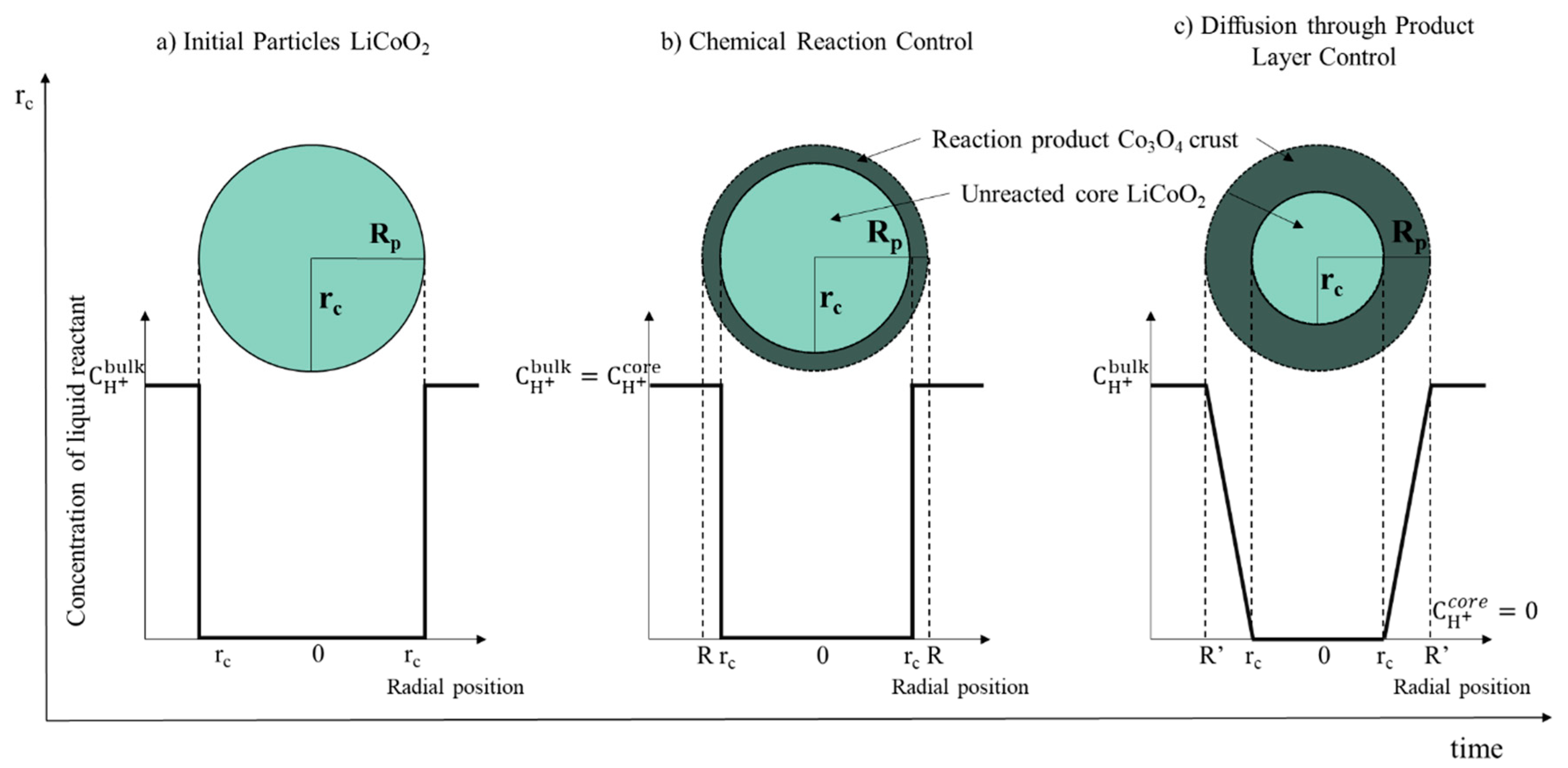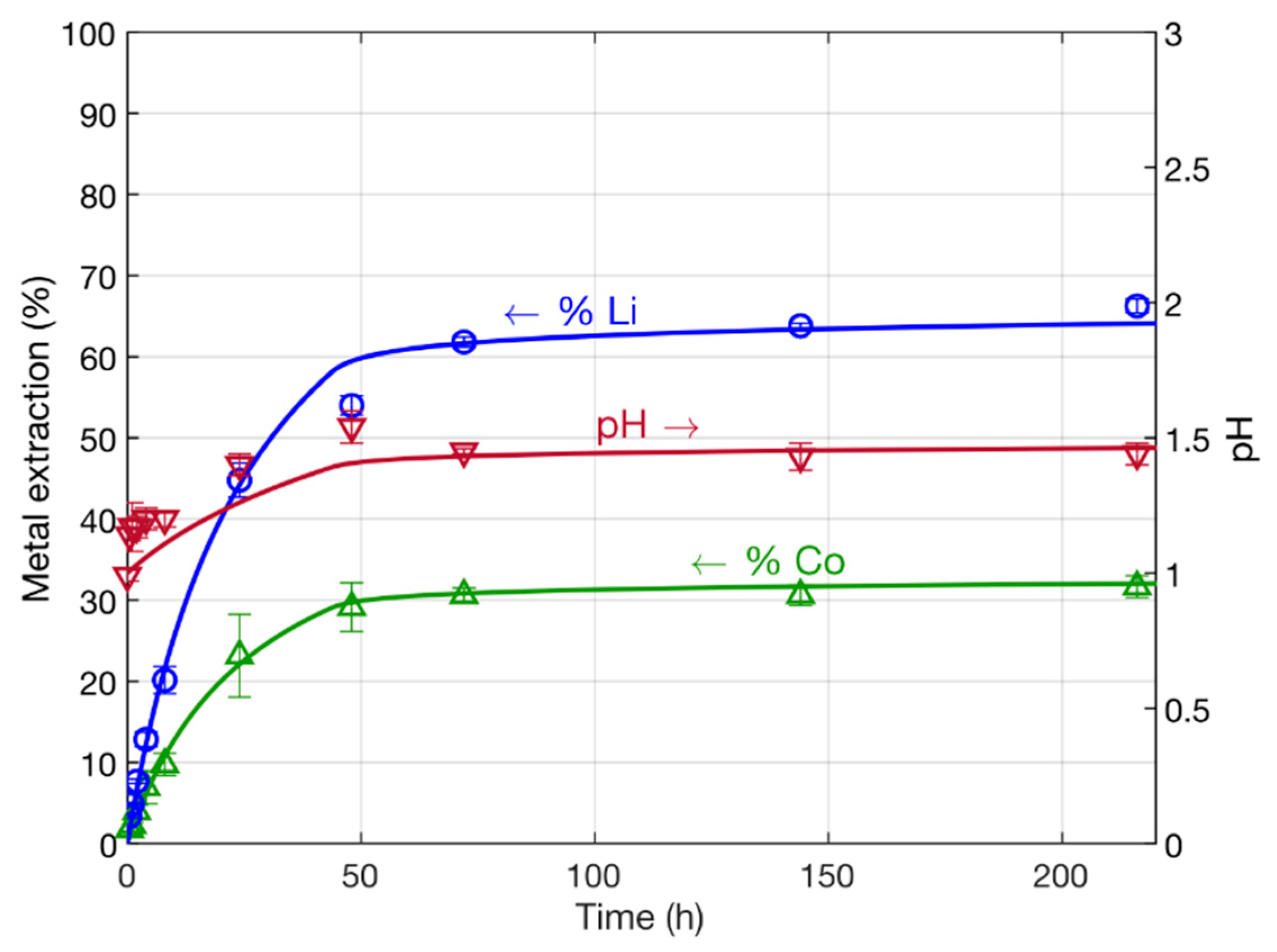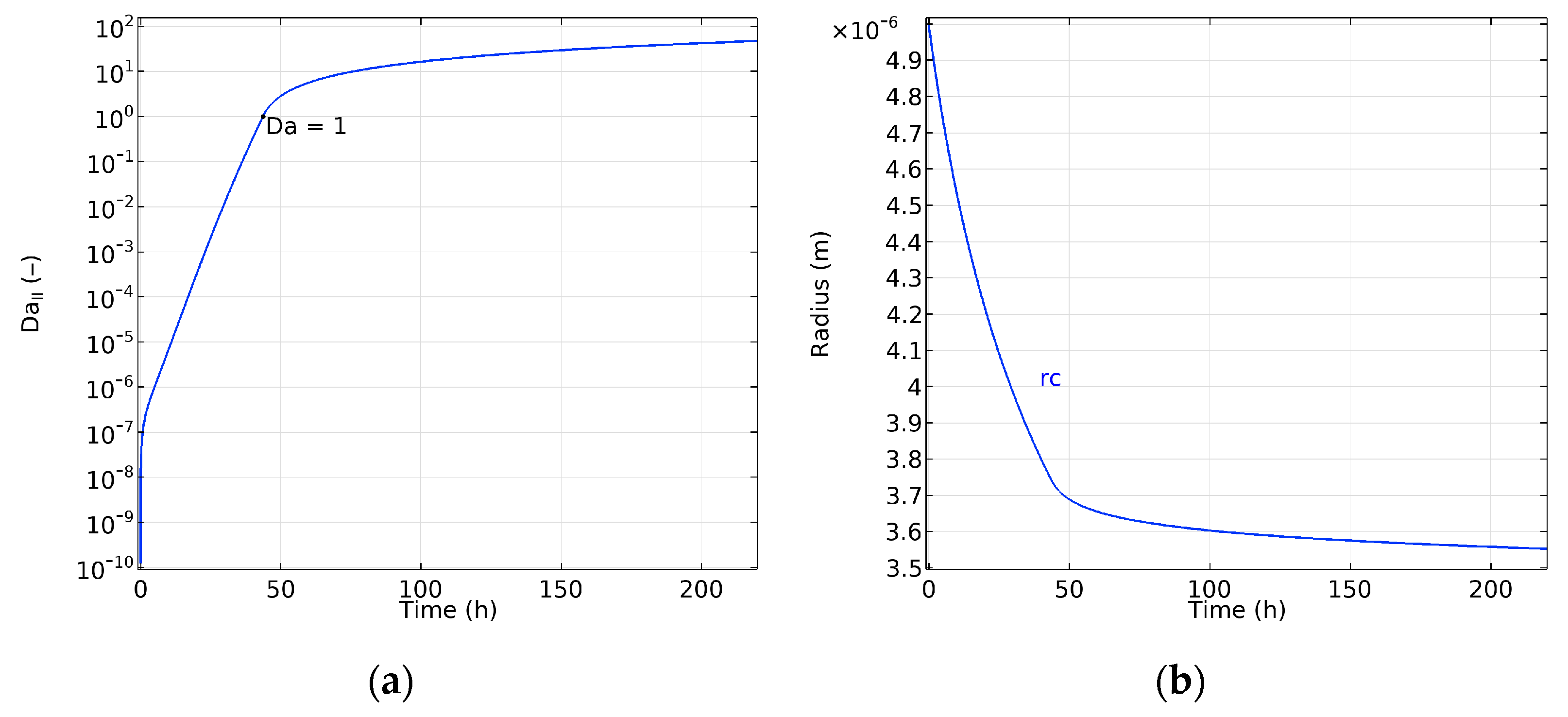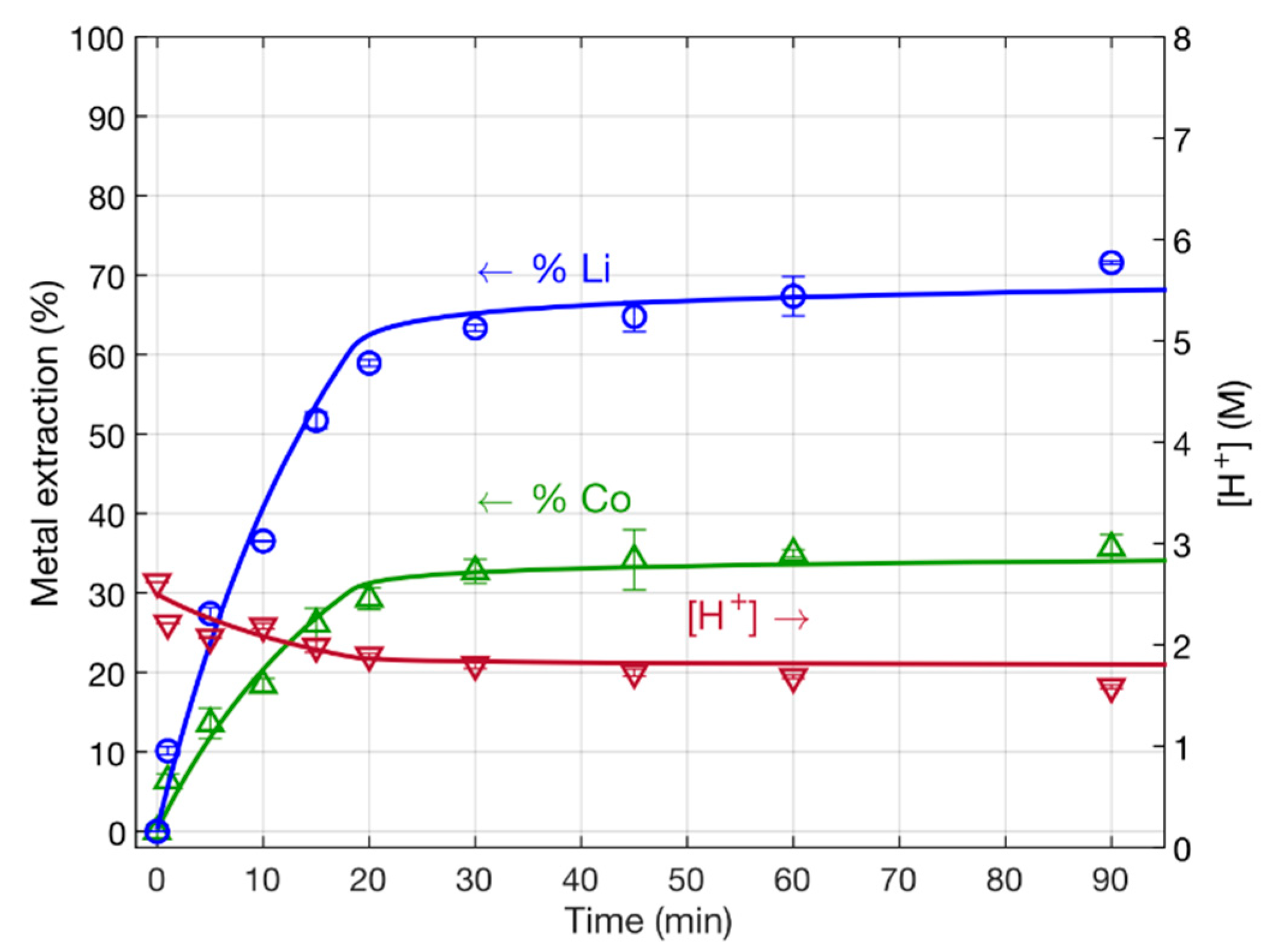Hydrometallurgical Extraction of Li and Co from LiCoO2 Particles–Experimental and Modeling
Abstract
Featured Application
Abstract
1. Introduction
- Li and Co extraction does not happen according to the stoichiometry of 1:1 expected from the dissolution of particles. More specifically, the molar amount of Li extracted seemed to be twice as much as that of Co.
- Leaching of particles does not happen to a full extent in reasonable times. The leaching process slows down to an apparent plateau in around 65–70% of Li extraction.
2. Materials and Methods
2.1. Extraction Experiments
2.2. Analytics
2.3. Physicochemical Model
- particles are assumed to be spherical with a mean initial radius of 5 µm that follows a normal distribution. During the reaction, the radius of the unreacted core decreases while the number of particles is considered constant.
- The extraction of lithium and cobalt from particles in acidic aqueous solution takes place according to the stoichiometry in Equation (8), which takes into account that the dissolution of particles produces Li and Co in a proportion of 2:1, as well as the formation of an outer crust layer of (s) in the external surface of (s) core.
- The kinetic rate for the reaction in Equation (8) is given by:where (mol m−3) is the molar density of , (–) is the number of particles, (m) is the radius of the unreacted core, () is the kinetic constant and (mol m−3) is the concentration of protons in the position , and (–) is the reaction order with respect to the protons.
- The rate of and production and consumption in the extracting liquid, assumed with a constant volume of (), is given by:
- The outer crust of , which forms during the process, is supposed to be porous. As it forms, the size of the particle remains constant and equal to the initial. Diffusion of the reactant, namely, the , through the layer of from the bulk liquid to the surface of the unreacted core is described as:where is the concentration of protons in the bulk liquid, and (m2 s−1) is the effective diffusion coefficient of the proton through the layer of . The effective diffusion coefficient is considered to change as the crust increases, according to the following expression:(m2 s−1) is the diffusion coefficient at infinite dilution ( [27]), (–) is the porosity, (–) is the percentage of cobalt extracted, and (m−1) is a parameter that measures the increase of the resistance to the mass transport as the crust increases as a consequence of changes in porosity or tortuosity, including pore closing due to counter diffusion of the gas formed in the reaction. (–) is included in the equation to take into account the formation of (g) and accumulation within the porous structure.
- As the reaction proceeds and the outer crust increases, resistance to the diffusion transport increases according to Equation (14). At a certain thickness of the crust, the process reaches a point in which the rate of proton diffusion is lower than the chemical kinetic consumption. At this point, as soon as protons reach the reactive surface, they are consumed by the reaction.The second Damköhler number, (–), defined in Equation (15) as the ratio of the chemical reaction rate to the mass transfer rate, is used to identify the controlling mechanisms.
- Combining Equations (9), (12), and (13), it can stated that:where, if , then , and the process rate is defined by the chemical kinetics law. However, whenever , then , and the process rate is controlled by the diffusion. The change of control mechanism is schematized in Figure 1.
- The Diffusion of and through the (s) crust layer to the bulk solution is considered to have no effect on the process rate. Additionally, the system is considered well stirred to assume the mass transfer resistance through the limit layer between the bulk solution and the solid surface is negligible.
3. Results and Discussion
4. Conclusions
Author Contributions
Funding
Acknowledgments
Conflicts of Interest
References
- Choubey, P.K.; Chung, K.S.; Kim, M.S.; Lee, J.C.; Srivastava, R.R. Advance review on the exploitation of the prominent energy-storage element Lithium. Part II: From sea water and spent lithium ion batteries (LIBs). Miner. Eng. 2017, 110, 104–121. [Google Scholar] [CrossRef]
- Mossali, E.; Picone, N.; Gentilini, L.; Rodrìguez, O.; Pérez, J.M.; Colledani, M. Lithium-ion batteries towards circular economy: A literature review of opportunities and issues of recycling treatments. J. Environ. Manag. 2020, 264, 110500. [Google Scholar] [CrossRef] [PubMed]
- Wang, Y.; An, N.; Wen, L.; Wang, L.; Jiang, X.; Hou, F.; Yin, Y.; Liang, J. Recent progress on the recycling technology of Li-ion batteries. J. Energy Chem. 2020, 55, 391–419. [Google Scholar] [CrossRef]
- Huang, T.; Liu, L.; Zhang, S. Recovery of cobalt, lithium, and manganese from the cathode active materials of spent lithium-ion batteries in a bio-electro-hydrometallurgical process. Hydrometallurgy 2019, 188, 101–111. [Google Scholar] [CrossRef]
- Sonoc, A.C.; Jeswiet, J.; Murayama, N.; Shibata, J. A study of the application of Donnan dialysis to the recycling of lithium ion batteries. Hydrometallurgy 2018, 175, 133–143. [Google Scholar] [CrossRef]
- Villen-Guzman, M.; Arhoun, B.; Vereda-Alonso, C.; Gomez-Lahoz, C.; Rodriguez-Maroto, J.M.; Paz-Garcia, J.M. Electrodialytic processes in solid matrices. New insights into battery recycling. A review. J. Chem. Technol. Biotechnol. 2019, 94, 1727–1738. [Google Scholar] [CrossRef]
- Georgi-Maschler, T.; Friedrich, B.; Weyhe, R.; Heegn, H.; Rutz, M. Development of a recycling process for Li-ion batteries. J. Power Sources 2012, 207, 173–182. [Google Scholar] [CrossRef]
- Nayaka, G.P.; Manjanna, J.; Pai, K.V.; Vadavi, R.; Keny, S.J.; Tripathi, V.S. Recovery of valuable metal ions from the spent lithium-ion battery using aqueous mixture of mild organic acids as alternative to mineral acids. Hydrometallurgy 2015, 151, 73–77. [Google Scholar] [CrossRef]
- Jha, M.K.; Kumari, A.; Jha, A.K.; Kumar, V.; Hait, J.; Pandey, B.D. Recovery of lithium and cobalt from waste lithium ion batteries of mobile phone. Waste Manag. 2013, 33, 1890–1897. [Google Scholar] [CrossRef]
- Lee, C.K.; Rhee, K.I. Preparation of LiCoO2 from spent lithium-ion batteries. J. Power Sources 2002, 109, 17–21. [Google Scholar] [CrossRef]
- Meshram, P.; Pandey, B.D.; Mankhand, T.R. Hydrometallurgical processing of spent lithium ion batteries (LIBs) in the presence of a reducing agent with emphasis on kinetics of leaching. Chem. Eng. J. 2015, 281, 418–427. [Google Scholar] [CrossRef]
- Li, J.; Yang, X.; Fu, Y.; Huang, H.; Zhong, Z.; Wang, Y. Recovery of Fe, Mn, Ni and Co in sulfuric acid leaching liquor of spent lithium ion batteries for synthesis of lithium ion-sieve and NixCoyMn1-x-y(OH)2. Hydrometallurgy 2019, 190, 105190. [Google Scholar] [CrossRef]
- Musariri, B.; Akdogan, G.; Dorfling, C.; Bradshaw, S. Evaluating organic acids as alternative leaching reagents for metal recovery from lithium ion batteries. Miner. Eng. 2019, 137, 108–117. [Google Scholar] [CrossRef]
- Gao, W.; Liu, C.; Cao, H.; Zheng, X.; Lin, X.; Wang, H.; Zhang, Y.; Sun, Z. Comprehensive evaluation on effective leaching of critical metals from spent lithium-ion batteries. Waste Manag. 2018, 75, 477–485. [Google Scholar] [CrossRef]
- Zhang, X.; Cao, H.; Xie, Y.; Ning, P.; An, H.; You, H.; Nawaz, F. A closed-loop process for recycling LiNi1/3Co1/3Mn1/3O2 from the cathode scraps of lithium-ion batteries: Process optimization and kinetics analysis. Sep. Purif. Technol. 2015, 150, 186–195. [Google Scholar] [CrossRef]
- Ferrier, R.J.; Cai, L.; Lin, Q.; Gorman, G.J.; Neethling, S.J. Models for apparent reaction kinetics in heap leaching: A new semi-empirical approach and its comparison to shrinking core and other particle-scale models. Hydrometallurgy 2016, 166, 22–33. [Google Scholar] [CrossRef]
- Levenspiel, O. Chemical reaction engineering. Ind. Eng. Chem. Res. 1999, 38, 4140–4143. [Google Scholar] [CrossRef]
- Safari, V.; Arzpeyma, G.; Rashchi, F.; Mostoufi, N. A shrinking particle-shrinking core model for leaching of a zinc ore containing silica. Int. J. Miner. Process. 2009, 93, 79–83. [Google Scholar] [CrossRef]
- Raschman, P.; Popovič, Ľ.; Fedoročková, A.; Kyslytsyna, M.; Sučik, G. Non-porous shrinking particle model of leaching at low liquid-to-solid ratio. Hydrometallurgy 2019, 190, 105151. [Google Scholar] [CrossRef]
- Homma, S.; Ogata, S.; Koga, J.; Matsumoto, S. Gas-solid reaction model for a shrinking spherical particle with unreacted shrinking core. Chem. Eng. Sci. 2005, 60, 4971–4980. [Google Scholar] [CrossRef]
- Meng, F.; Liu, Q.; Kim, R.; Wang, J.; Liu, G.; Ghahreman, A. Selective recovery of valuable metals from industrial waste lithium-ion batteries using citric acid under reductive conditions: Leaching optimization and kinetic analysis. Hydrometallurgy 2020, 191, 105160. [Google Scholar] [CrossRef]
- Li, L.; Bian, Y.; Zhang, X.; Xue, Q.; Fan, E.; Wu, F.; Chen, R. Economical recycling process for spent lithium-ion batteries and macro- and micro-scale mechanistic study. J. Power Sources 2018, 377, 70–79. [Google Scholar] [CrossRef]
- Setiawan, H.; Petrus, H.T.B.M.; Perdana, I. Reaction kinetics modeling for lithium and cobalt recovery from spent lithium-ion batteries using acetic acid. Int. J. Miner. Metall. Mater. 2019, 26, 98–107. [Google Scholar] [CrossRef]
- Cerrillo-Gonzalez, M.M.; Villen-Guzman, M.; Vereda-Alonso, C.; Gomez-Lahoz, C.; Rodriguez-Maroto, J.M.; Paz-Garcia, J.M. Recovery of Li and Co from LiCoO2 via Hydrometallurgical–Electrodialytic Treatment. Appl. Sci. 2020, 10, 2367. [Google Scholar] [CrossRef]
- Porvali, A.; Chernyaev, A.; Shukla, S.; Lundström, M. Lithium ion battery active material dissolution kinetics in Fe(II)/Fe(III) catalyzed Cu-H2SO4 leaching system. Sep. Purif. Technol. 2020, 236, 116305. [Google Scholar] [CrossRef]
- Li, L.; Bian, Y.; Zhang, X.; Guan, Y.; Fan, E.; Wu, F.; Chen, R. Process for recycling mixed-cathode materials from spent lithium-ion batteries and kinetics of leaching. Waste Manag. 2018, 71, 362–371. [Google Scholar] [CrossRef]
- Vanýsek, P. Equivalent Conductivity of Electrolytes in Aqueous Solution. In CRC Handbook of Chemistry and Physics; CRC Press: Boca Raton, FL, USA, 2013; p. 76. [Google Scholar]




| mLiCoO2 (mg) | Vsolution (mL) | [HCl] (M) | ||
|---|---|---|---|---|
| Experiment A | 125 | 25 | 5 | 0.1 |
| Experiment B | 1250 | 25 | 50 | 2.5 |
| Parameter | Value (Case A) | Value (Case B) | Unit | Description |
|---|---|---|---|---|
| Kinetic constant | ||||
| m−1 | Diffusion resistance factor | |||
| 3/2 | (–) | Order of reaction for | ||
© 2020 by the authors. Licensee MDPI, Basel, Switzerland. This article is an open access article distributed under the terms and conditions of the Creative Commons Attribution (CC BY) license (http://creativecommons.org/licenses/by/4.0/).
Share and Cite
Cerrillo-Gonzalez, M.d.M.; Villen-Guzman, M.; Acedo-Bueno, L.F.; Rodriguez-Maroto, J.M.; Paz-Garcia, J.M. Hydrometallurgical Extraction of Li and Co from LiCoO2 Particles–Experimental and Modeling. Appl. Sci. 2020, 10, 6375. https://doi.org/10.3390/app10186375
Cerrillo-Gonzalez MdM, Villen-Guzman M, Acedo-Bueno LF, Rodriguez-Maroto JM, Paz-Garcia JM. Hydrometallurgical Extraction of Li and Co from LiCoO2 Particles–Experimental and Modeling. Applied Sciences. 2020; 10(18):6375. https://doi.org/10.3390/app10186375
Chicago/Turabian StyleCerrillo-Gonzalez, Maria del Mar, Maria Villen-Guzman, Luis Fernando Acedo-Bueno, Jose Miguel Rodriguez-Maroto, and Juan Manuel Paz-Garcia. 2020. "Hydrometallurgical Extraction of Li and Co from LiCoO2 Particles–Experimental and Modeling" Applied Sciences 10, no. 18: 6375. https://doi.org/10.3390/app10186375
APA StyleCerrillo-Gonzalez, M. d. M., Villen-Guzman, M., Acedo-Bueno, L. F., Rodriguez-Maroto, J. M., & Paz-Garcia, J. M. (2020). Hydrometallurgical Extraction of Li and Co from LiCoO2 Particles–Experimental and Modeling. Applied Sciences, 10(18), 6375. https://doi.org/10.3390/app10186375







